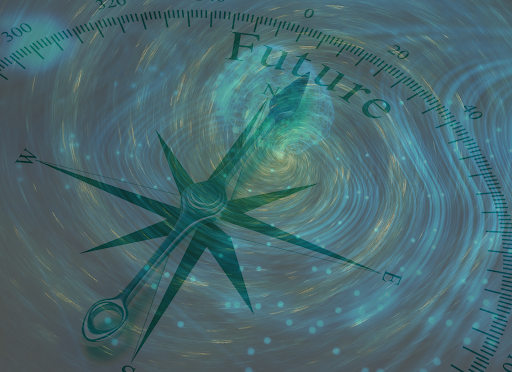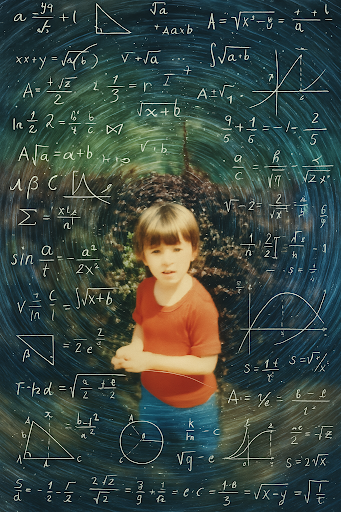By Cyndi Coon

I grew up poor in rural western Michigan. Dirt-under-the-fingernails, government-cheese, make-your-own-fun kind of poor. The only things I had in abundance were imagination and grit. I was neurodivergent and undiagnosed, navigating the world by spotting patterns no one else seemed to notice. While other kids focused on finding the “right answer,” I was following the shape of the question.
I didn’t know it yet, but I was doing math. It just didn’t look like what I saw in my rural high school.
School math felt like another planet. I was the creative kid. I wore power suits to high school and built entire cities out of cardboard. I had my future all mapped out by sixteen. But if you asked me to show my work on a math problem, I’d freeze. I was told I was bad at math, and I believed it for a long time.

Jump ahead a few decades. I’m now an applied futurist. I work with military teams, government agencies, and enterprise leaders to map out what the world might look like in the future. I help people imagine what’s next, then make plans to either enable or prevent it. I use research, data, and storytelling to do that. But underneath all of it is math.
Not the kind of math that shows up on a multiple-choice test. I’m talking about mapping systems, modeling behavior, tracking trajectories, and identifying patterns over time horizons. It's math in motion. It's math that helps us see around corners. It’s also kind of magical.
In the workshops I lead, whether with generals or artists, we build speculative futures. We look at how one small change can ripple out into something much bigger. We model cause and effect, calculate possibilities, and design systems that help people prepare. No one in the room says they’re doing math. But we are.
In one Applied Futures Lab workshop, we modeled the trajectory of a visually impaired individual. Her story was built using real-world data, including broadband access gaps, local income levels, and AI training data structures. We mapped how machine learning could be trained to accommodate diverse cognitive and sensory needs, then backcasted the indicators needed to make that shift viable by 2035. We identified key “flags” like the creation of diverse training datasets and government policies for education. It looked like storytelling on the surface but underneath, we were running time-sequenced logic models and systems mapping. That’s math. Quietly doing the heavy lifting behind a better future.
Then came generative AI. When ChatGPT and other tools hit the scene in 2022, I jumped in right away. Not for the tech. For the possibilities. I saw a creative playground. I saw a place for storytelling and experimentation.
And you know what was waiting for me in that playground? Math. Again.
I began creating new worlds with AI, using patterns from nature, repeating shapes, and designs that resonate with the human eye. I created digital characters I call “Scouts.” They explore potential futures and report back. These Scouts are shaped by algorithms and structured around things like vector math and probability curves. I’m now vibecoding to build entire environments. That is something younger me would have sworn I could never do.
I’ve helped design a speculative national innovation hub as a future-forward campus imagined for a set of global cities. We modeled foot traffic with probability curves and used fractal geometry to design inclusive spaces that adapt over time. It looked like visionary design but math shaped every layer.
I’ve asked teams to design AI-powered time machines. They giggle, then they get weird, then they create together. But beneath all that play, we’re working with time intervals, scenario frameworks, and logic sequences. Nobody calls it math. But it’s there, quietly supporting the whole thing.
That’s when it really clicks. When math is wrapped up in curiosity and creativity, it stops being intimidating and starts being helpful. Sometimes it’s even friendly. You don’t have to be “good at math” to have a relationship with it. You just have to let it in.
I’d say I’m in a relationship with math. We had a tough beginning. We didn’t understand each other at first. But we’ve found our rhythm now. I didn’t find math in a classroom. I found it in the patterns of my life, in the spiral of creative work, in the moments where logic and intuition meet.
Math isn’t the villain I once thought it was. It’s not just rules and formulas and creativity. It’s a partner. A collaborator. A guide.
I’m not solving for x every day, and that's okay because I’m co-authoring what’s next.

Cyndi Coon is an Applied Futurist and founder of Applied Futures Lab. She co-founded Threatcasting Lab and Threatcasting.ai, designing future systems for defense, enterprise, academia and creative sectors. Cyndi leads cross-sector teams to build tactical prototypes and self-powered solutions that shape what comes next. Her work blends imagination, analog tools, and emerging tech to navigate complex futures.
Connect on LinkedIn
Connect on X
Connect on LinkTree